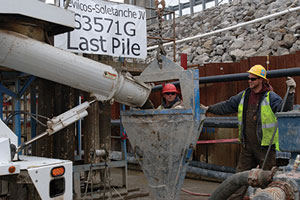Foundation Drilling Industry is the Support Underneath It All


|
| A massive, complex project recently breathed life into the Wolf Creek Dam in Jamestown, Ky. Source: Leon Roberts, Army Corps of Engineers |
The dictionary also talks about a foundation as “something (such as an idea, a principle or a fact) that provides support.”
Most people — and I think this includes a lot of crews in the foundation drilling industry — think about that first definition. But I think both play an important role in what foundation drillers do.
Yes, foundations support dams, buildings small and large, even offshore windmills. In that respect, the work done by foundations and geotechnical drillers is vital. But that’s the “surface” definition. What does it mean that we have all of these things?
Let’s dig a little deeper.
Take a structure like a skyscraper. The foundation for a large building can stretch hundreds of feet below the street level — the level that most people see. Below ground, the foundation may serve an obvious practical function (like parking), but what the engineers and building crews concern themselves with is how well it supports and distributes the massive weight of the building.
But, let’s dig a little deeper. The foundation enables the building to serve its function. A building’s function could be for commerce, government, banking or whatever.
So, in a very real way, a building’s form — the foundation that gives it the strength to keep standing — is “an idea, a principle or a fact,” that supports its function. Form enables function.
The same could be said for a dam, a stretch of land reinforced by soil mixing, a windmill. Wolf Creek Dam in Kentucky is a form. It’s now a much more reliable form after much needed reinforcement, but at its most basic definition, it’s a form. That basic form enables recreation, power generation and flood control.
The foundation of the rebuilt One World Trade Center in New York City is a form, and an impressive one at that. It stretches hundreds of feet down to Manhattan bedrock to enable functions like commerce, community and banking.
I could go on, but you get the idea. What the foundations industry does serves a practical, tangible purpose. Buildings need foundations. But the work foundations drillers and engineers do also represents an idea that underlies much of what we might call civilization.
The great cities, highways, bridges and other infrastructure that enable the modern world — a world most people take for granted — stand on the shoulders of the work done in the deep foundations industry.
This issue, as you’ve probably guessed, puts the spotlight on the work done by foundations and geotechnical drillers and engineers. Joe Cubicle takes it all for granted. He drives into the city, parks in his underground garage and takes the elevator to his office with a view of the skyline. He doesn’t see the work that you do.
But you know it. And we’ll keep talking about it here at National Driller. That’s why we cover the deep foundations industry and why we’re attending the International Foundations Congress and Equipment Expo (IFCEE) this month in San Antonio.
In an interview for this issue (page 10), industry veteran Frank Rausche calls the IFCEE the “Olympics of the deep foundations industry.” I’ve no doubt it’ll live up to that hype.
If you’re attending the event, stop by Booth 200 and introduce yourself. I’d like to hear about some of those projects you do that people outside the industry take for granted.
Stay safe out there, drillers.
Looking for a reprint of this article?
From high-res PDFs to custom plaques, order your copy today!





